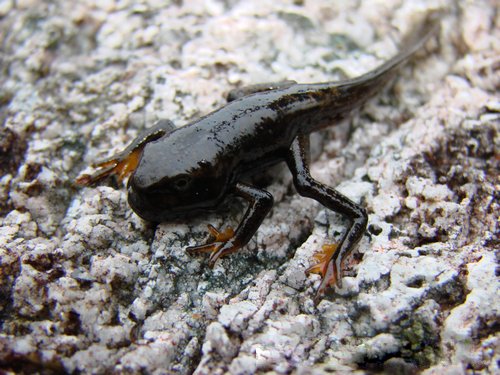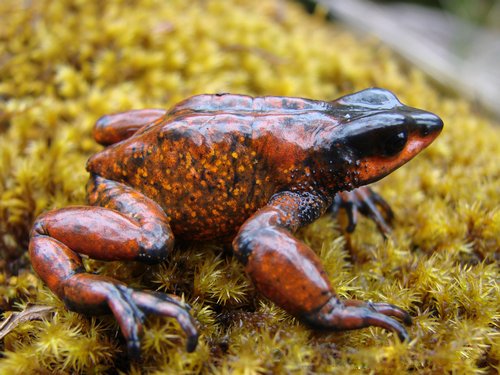- Unveiling Atelopus carrikeri: The Hidden Jewel of the Andes
- Taxonomy and Classification: A Precious Amphibian Lineage
- The Natural Habitat of Atelopus carrikeri: Cloud Forest Symphony
- Distinctive Physical Characteristics: Small Wonders of Evolution
- The Life Story of Carriker’s Harlequin Frog: Behaviors and Life Cycle
- Ecological Role: An Indicator of Ecosystem Health
- Threats and Conservation Status: A Fragile Existence
- Cultural and Scientific Significance: Beyond Biological Wonders
- Conclusion: Guardians of the Cloud Forest
Unveiling Atelopus carrikeri: The Hidden Jewel of the Andes#
Nestled amidst the mist-shrouded slopes of Colombia’s majestic Sierra Nevada de Santa Marta mountains, a brightly colored amphibian, small and delicate yet remarkably resilient, lives quietly among moss-draped forests and crystal-clear mountain streams. Known scientifically as Atelopus carrikeri, Carriker’s Harlequin Frog captures the fascination of researchers, conservationists, and wildlife enthusiasts alike—not only because of its stunning appearance but due to its precarious status and unique ecological role in one of the world’s most biologically diverse regions.
A symbol of fragile beauty tempered by innate toughness, this intriguing amphibian tells a powerful story about biodiversity, climate change, and conservation in the Colombian Andes. Read on to journey deep into cloud forests, exploring the fascinating life, history, behavior, and future of Atelopus carrikeri.
Taxonomy and Classification: A Precious Amphibian Lineage#
Atelopus carrikeri belongs to the Bufonidae family, a family commonly known as true toads. Within this family sits the genus Atelopus, an extraordinary group often referred to as “Harlequin Frogs,” famed for their striking colors and unique patterns. These frogs stand distinctly apart from the stereotypical image of toads many hold in their minds, trading rough texture for bright colors and sleek skin marked with strikingly vivid lines and shades.
First described scientifically by Alexander Grant Ruthven in 1916, Atelopus carrikeri was named in honor of the respected ornithologist and collector Melbourne Armstrong Carriker Jr., who extensively explored and documented Colombia’s rich biodiversity in the early twentieth century. This commemorative naming reflects the deep history of biological exploration and scientific curiosity that underpins our understanding of this extraordinary species.
The Natural Habitat of Atelopus carrikeri: Cloud Forest Symphony#
To truly comprehend the significance of Carriker’s Harlequin Frog, one must first wander into its native home—a landscape where rolling mist blankets dense, lush vegetation and mountain streams whisper melodically through verdant undergrowth. Endemic exclusively to the Sierra Nevada de Santa Marta region of Northern Colombia, Atelopus carrikeri inhabits cloud and montane forests between elevations of about 2,350 and 4,800 meters above sea level.
The constant high-elevation fog and abundant precipitation lend this ecosystem its distinctive, dreamlike quality. Moss carpets every available surface, while bromeliads and orchids cling determinedly to branches. The gentle streams carving through the hillsides support myriad life forms, making ideal habitats for delicate amphibians like Carriker’s Harlequin Frog.
This habitat is not simply where the frogs happen to live—it shapes their entire existence. The high humidity and cool temperatures of the cloud forest regulate their delicate amphibian skin, critical for maintaining moisture and enabling respiration. The pristine waterways form breeding grounds and nurseries for their tadpoles, supplying fresh, oxygen-rich pools necessary for successful reproduction.
Distinctive Physical Characteristics: Small Wonders of Evolution#
No bigger than a thumb pad, reaching approximately 2.5 to 4 cm in length, Atelopus carrikeri is petite yet strikingly memorable. It wears nature’s artistry elegantly—its smooth, moist skin displaying radiant colors that demand attention at first sight. Bright to pale yellows, vibrant oranges, and deep reds mix harmoniously with bold black or dark-green markings, patterns unique to each individual frog, much like a human fingerprint.
This flamboyant coloration is more than mere decoration. It announces to potential predators a clear ecological message: danger! Harlequin Frogs produce powerful toxins sequestered in their skin—a defensive adaptation known as aposematic coloration—warning birds, snakes, and other predators to steer clear to avoid unpleasant consequences.
Adaptations such as slender limbs and long, agile toes with rounded adhesive pads equip them expertly for life along slippery rocks and water-slick vegetation, a crucial survival trait in their moisture-rich environment. In certain individuals, an exaggerated protrusion of the snout may be evident, adding subtle charisma and distinguishing Carriker’s frog from closely related species.
The Life Story of Carriker’s Harlequin Frog: Behaviors and Life Cycle#
Feeding Habits: Small but Mighty Predators#
Invisible worlds teem with life in the humid undergrowth of cloud forests, providing Carriker’s Harlequin Frogs with an abundant source of dietary staples. Small insects, including ants, termites, beetles, and minute arachnids, compose their primary diet. The frogs employ precise feeding techniques, using their sticky, projectile tongues to swiftly trap unsuspecting prey.
Mating Rituals and Parental Care: A Delicate Dance#
When rainy season arrives, the serene mountain streams echo with the sounds of amphibian calls—a signal that breeding time has come. Although less vocal compared to other frogs, male Carriker’s Harlequin Frogs perform subtle calls and visual displays along stream banks. Their courtship is gracefully intricate, with bright pattern displays enhancing visual signaling to potential mates.
After successful courtship, females deposit eggs along streamside vegetation or submerged rocks, carefully selecting areas of slow-moving water. These eggs soon hatch into agile tadpoles uniquely adapted to fast-flowing mountain streams, exhibiting streamlined bodies and robust mouthparts designed to scrape algae from rock surfaces.
The careful selection of nesting sites and timing of tadpole hatching are critical behaviors in a risky environment—thus ensuring a higher chance for offspring to reach maturity and continue the species’ legacy amid harsh mountain conditions.
Ecological Role: An Indicator of Ecosystem Health#
Despite its small size, the role of Atelopus carrikeri within its ecosystem is expansive and essential. Acting both as predator of tiny arthropods and prey to larger vertebrates, Carriker’s Harlequin Frog is a critical intermediary link in the food web.
Furthermore, this species acts as an excellent indicator of environmental health. With their highly permeable skin and sensitivity to environmental changes, the presence and population size of these frogs directly reflect the ecological health of their habitat, highlighting issues such as water pollution or subtle climatic changes. They are sentinel species, providing early warnings of potential trouble in their delicate and vulnerable mountainous ecosystem.
Threats and Conservation Status: A Fragile Existence#
The charm and beauty of Atelopus carrikeri contrast sharply with its sobering conservation story. Classified under the IUCN Red List as Critically Endangered, its population has experienced sharp declines driven by multiple threats. Habitat degradation and losses from agriculture, illegal logging, and mining operations threaten the frog’s fragile home, while climate change brings unprecedented alterations in rainfall patterns and temperatures, challenging species adapted specifically to stable cloud-forest conditions.
Perhaps most ominous is the global amphibian pandemic—chytridiomycosis—which has decimated frog populations worldwide. The chytrid fungus wreaks havoc by disrupting skin functions, devastating entire amphibian communities. Atelopus carrikeri populations have significantly declined due to this pathogen, dramatically hindering their chances of recovery without urgent intervention.
Encouragingly, conservation groups in Colombia and internationally are spearheading conservation initiatives, including captive breeding and habitat restoration projects. Educational programs raise awareness, while scientific research continues unraveling the secret lives and survival mechanisms of this elusive frog, giving hope that the species can be safeguarded for future generations.
Cultural and Scientific Significance: Beyond Biological Wonders#
As masterfully adapted indicators of ecological balance, Harlequin Frogs—including Atelopus carrikeri—have come to symbolize the global amphibian extinction crisis, making them flagship species for conservation campaigns. This symbolic significance unites scientists, environmental organizations, and local communities in collective efforts to preserve precious natural heritages.
Additionally, scientific studies frequently explore Harlequin Frogs for promising medical and pharmaceutical potentials, including studies of naturally occurring amphibian toxins that could have therapeutic implications. Their existence and survival might someday influence critical human innovations.
Conclusion: Guardians of the Cloud Forest#
Atelopus carrikeri, small yet extraordinary, epitomizes the remarkable resilience and vulnerability inherent within delicate mountain ecosystems. Through its intricate colors, specialized behaviors, and pivotal ecological role, Carriker’s Harlequin Frog invites us into a larger conversation—about ecological protection, conservation strategies, and our responsibility to safeguard Earth’s intricate tapestry of biodiversity.
Embracing conservation efforts today can ensure that future generations walk along fog-shrouded streams where the vibrant colors and gentle calls of Carriker’s Harlequin Frog still brighten and enrich our wild, wondrous Earth.












